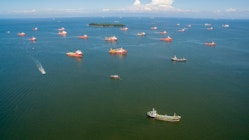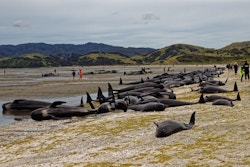World Oceans Day: giving voice to the world of silence
Immersing a hydrophone in the water takes you on a journey of discovery of the underwater world through the ears, rather than the eyes, of its inhabitants. For this World Oceans Day, the theme put forward by the United Nations in 2020 is “Innovation for a Sustainable Ocean”. Dr Katia Nicolet, a scientist aboard Energy Observer, invites us to re-examine a little-known issue: noise pollution in the oceans and how to remedy the problem.
The song of Life
Since Cousteau’s time, our perception of the ocean involves a silent world. This could not be further from the truth. Indeed, this vast blue space is filled with sonorous messages that travel hundreds of kilometres, the passing on of information and the maintaining of social bonds between underwater creatures.
The larvae of reef fish, for example, live out at sea and locate the reef thanks to its sound. This same homing instinct can even be used to assist in the recruitment of juveniles on damaged reefs. Indeed, after events such as a coral bleaching episode, the fish lose their home as the reef dies and becomes silent. This inevitably leaves the juveniles feeling disorientated. However, some scientists have now managed to increase the recruitment of young fish by emitting the sounds of healthy reefs to guide them.
Marine mammals like dolphins and whales devote three times the amount of neurons to hearing than land-based mammals. The reasoning behind this is that through their songs and their clicks, these creatures are able to communicate with one another, find partners, hunt their prey, move around and understand their environment.
This dark world is full of sounds forming a genuine underwater song of life.
Chronic noise pollution
Within that world, there are however two types of noise pollution, chronic and acute noise pollution.
Chronic noise pollution is the result of shipping and this disturbance has doubled every ten years since the eighties. Every vessel emits noise through vibrations, the running of engines, cooling pumps and the cavitation of propellers and so on. Naturally, this hubbub has an impact on all the underwater life.

Among the mammal kingdom, this does not prevent them communicating, finding a partner or hunting. When the pollution is not too loud, cetaceans increase the volume of their song and their clicks in the same way as we raise our voices to speak above very loud music. However, if the volume of the noise pollution continues to rise, cetaceans will fall silent.

It has also been proven that constant noise pollution increases cetaceans’ stress levels. Equally, among orcas, an increase in noise causes a 25% reduction in their hunting time. Among fellow marine species, it has been shown that some crabs spend more time patrolling to protect themselves from a non-existent threat than they do taking care of their eggs. One species of damselfish, Pomacentrus amboinensis, struggles to pinpoint its predators and has seen its survival rate halved when it is exposed to boats making too much noise.
Acute noise pollution
Acute noise pollution is even more alarming. This is caused by seismic testing with airguns discharging bubbles of compressed air. This technique is used to detect oilfields on the ocean floor, deploying 30 to 40 airguns, which detonate at the same time. The sound emitted by these blasts is equivalent to a rocket lifting off or an underwater volcanic eruption. Furthermore, these explosions are repeated every 9 to 12 seconds, for weeks or even months on end. These techniques measure 220 to 250 decibels (the pain threshold is 120dB), a sound so loud that surveys in Ireland can be heard across the Atlantic and as far away as the East coast of the United States.
Among cetaceans, this acute noise pollution causes them physical injury ranging from hearing loss to haemorrhaging of the heart and brain, which can lead to the animal’s death. Even when these explosions do not prove fatal, they cause disorientation and panic, leading to mass stranding.

Stranded dolphins in Northern Europe
Some whales have been witnessed hiding behind rocks to protect themselves from the noise, or surfacing quickly in a bid to keep their head and ears above the water.
Still precious little is known about the impact of these seismic surveys on the rest of the underwater creatures. However, evidence is mounting and it is frightening. In Spain, between 2001 and 2003, the mass stranding of giant squid was observed after the use of airguns. A study exposing octopus, cuttlefish and squid to noise pollution in a laboratory also shows that low density, low frequency sound (50 to 400 hertz) causes lesions and ruptures of the statocyst, the organ responsible for balance, orientation and hearing among invertebrates. It is highly likely that underwater noise pollution hinders cephalopods in the ability to hunt, outmanoeuvre predators and even reproduce.
More problematic still, the use of airguns or compressed air pistons is decimating zooplankton, these minute organisms at the bottom of the food chain. The resulting explosion is such that it kills plankton up to a maximum of 1.2km away from the blast site, which suggests that the impact could be even greater. Destroying plankton is the aquatic equivalent of burning down a forest, reducing the very foundation of the ecosystem to nothing.
Innovations and solutions
Let’s not underestimate the impact of noise pollution then. In Guantanamo, prisoners are tortured by songs played constantly at high volume for days on end with the aim of making them go insane. What we’re doing to marine organisms is not so different.
However, there are solutions for reducing the impact our noise has on the marine world.
There is a new seismic survey technique called Vibroseis, which has the potential to reduce the amount of noise pollution. Unfortunately, Vibroseis also uses an amplitude of 210dB, albeit over a shorter time frame without a strong sonic ‘lag’ (between 170 and 210 dB), which cannot be used for seismic survey. As such, this new technique has less noise pollution ‘waste’, though it is still far from harmless for marine organisms.
With regards to maritime noise pollution, the sheer fact of raising machines up so that they no longer touch a boat’s hull drastically reduces the noise transmitted into the marine environment. Podded gearless propulsion systems are also a promising concept once they are coupled with a fuel cell. Enhanced propellers, which prevent cavitation (the formation of bubbles by the movement of a propeller through it), also enhance a vessel’s output and reduce the interference in terms of noise. Of course, the electric motor most definitely remains the best choice for reducing our impact, as it does not produce an explosion, requires fewer moving mechanical parts and hence requires little or no cooling. All these factors make it a lot quieter than its petrol-fuelled counterpart.
Over the past 3 years, Energy Observer has proven that the use of electric propulsion, even offshore, is achievable. Using the wind, sun and water, it is possible to produce clean electric energy, store it as hydrogen and use it when the time is right. At sea, this energy revolution makes it possible to go on a voyage without polluting the water and without polluting the ears of the ocean’s inhabitants.